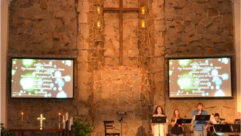
A Wiz of an Installation
Mar 15, 2011 10:18 AM,
by George Petersen

The Wiz
This month marks the debut of CinemaCon (formerly ShoWest), the official convention of the National Association of Theatre Owners (NATO), which rolls into Caesars Palace in Las Vegas from March 28 through 31, 2011. Besides the events, seminars, and star-studded screenings of new feature films, movie theater owners can check out the exhibits of the latest technological advances and innovative concession offerings, ranging from sound and projection gear, to screens, seating, and everything you need for a well-stocked candy counter. With that in mind, I thought I’d reflect on one of the strangest theater installs I’ve done.
Way back in October 1978, I got a call to upgrade Oakland’s Parkway Theater (now unfortunately closed) with a Dolby Stereo system for the opening of the movie The Wiz. Nothing too unusual there—I figured the main complication would be squeezing a couple amp racks and the Dolby CP50 LCRS cinema processor into a tiny booth that was already crammed with two 35mm Cinemeccanica V8 projectors and a simple Xetron edge-foil cue automation system. No room for platters in this booth! Each V8 played huge 13,000ft. reels with a 2.5-hour capacity on a single reel. One projector handled the main downstairs cinema where the new sound system was planned; next to that, the other machine shot into two front-surface mirrors, creating a periscope to feed the smaller upstairs screen.
A Complication Arises
The Parkway has a sizeable stage area, so installing the three Altec A7-800 Voice of the Theatre speakers behind the perforated screen would be a breeze. Then came the bombshell. The theater owner had been talking to someone at Dolby who offered a new approach to the surround channel. Rather than hanging a couple discrete cabinets in the rear, the suggestion was to mount 72 individual boxes (each with an 8in. driver) side-by-side, lining the theater’s back wall. Yuck.
I started out doing the easy part—setting up the new A7s behind the screen, with the 800Hz horns mounted externally on top of the cabinets and aligned the HF driver voice coils with that of each woofer. Before completing assembly, I added some screws through the bottom surface, locking the enclosure to the stage floor. This prevents the speakers from wandering out the exit doors after a show. Don’t laugh—I’ve been out on more than a few service calls where this happened, so a couple screws to keep them from “sliding” is a good investment.
The surrounds weren’t so much fun. It meant a lot of transformers, a lot of wiring and each enclosure had to be secured to the old lath-and-plaster walls in this 1920-era theater—a huge installation job with lots of overtime. And being flush against each other, each of the 72 cabinets had to be fastened directly to the wall before routing the wiring, installing the 70V transformers, the drivers and the grills.
After swapping the old mono optical pickup for the Dolby Stereo part and a bit of booth cabling, I fired up the system and ran test tones and some musical material to ring out the room. But the best test was running a 35mm reel from The Band’s The Last Waltz—still today one of the best soundtracks ever. The room sounded pretty good. I wasn’t overly impressed with the “wall of sound” surrounds, but it wasn’t bad, although hardly worth all that expense and trouble.
It’s Showtime!
Come opening day, I arrived at 9 a.m., giving me ample time to make up the show—putting the film from the 2000ft. shipping reels into one continuous 13,000ft. reel—and do a test run before the opening matinee. Then, another shocker: Inside the metal film cans was a note that read “Dear Mr. Projectionist: To enhance the theatrical quality of The Wiz, this film has no surround channel.” Sometimes the best laid plans…
George Petersen is also an IATSE journeyman and the Director of the TECnology Hall of Fame.










